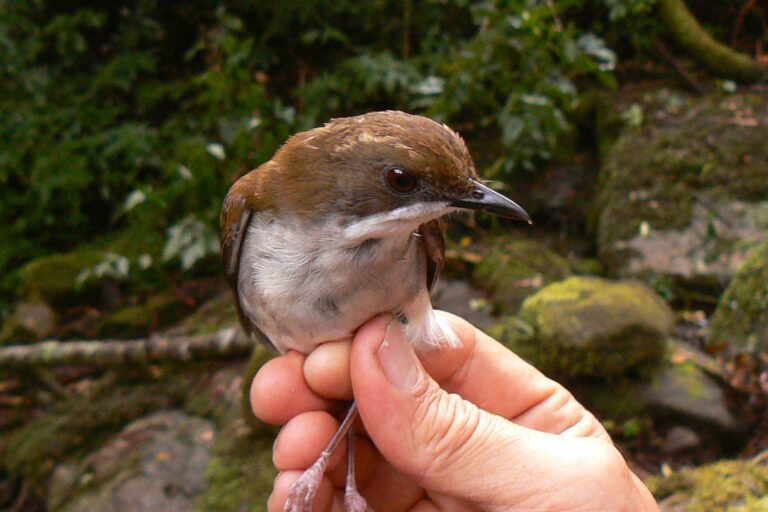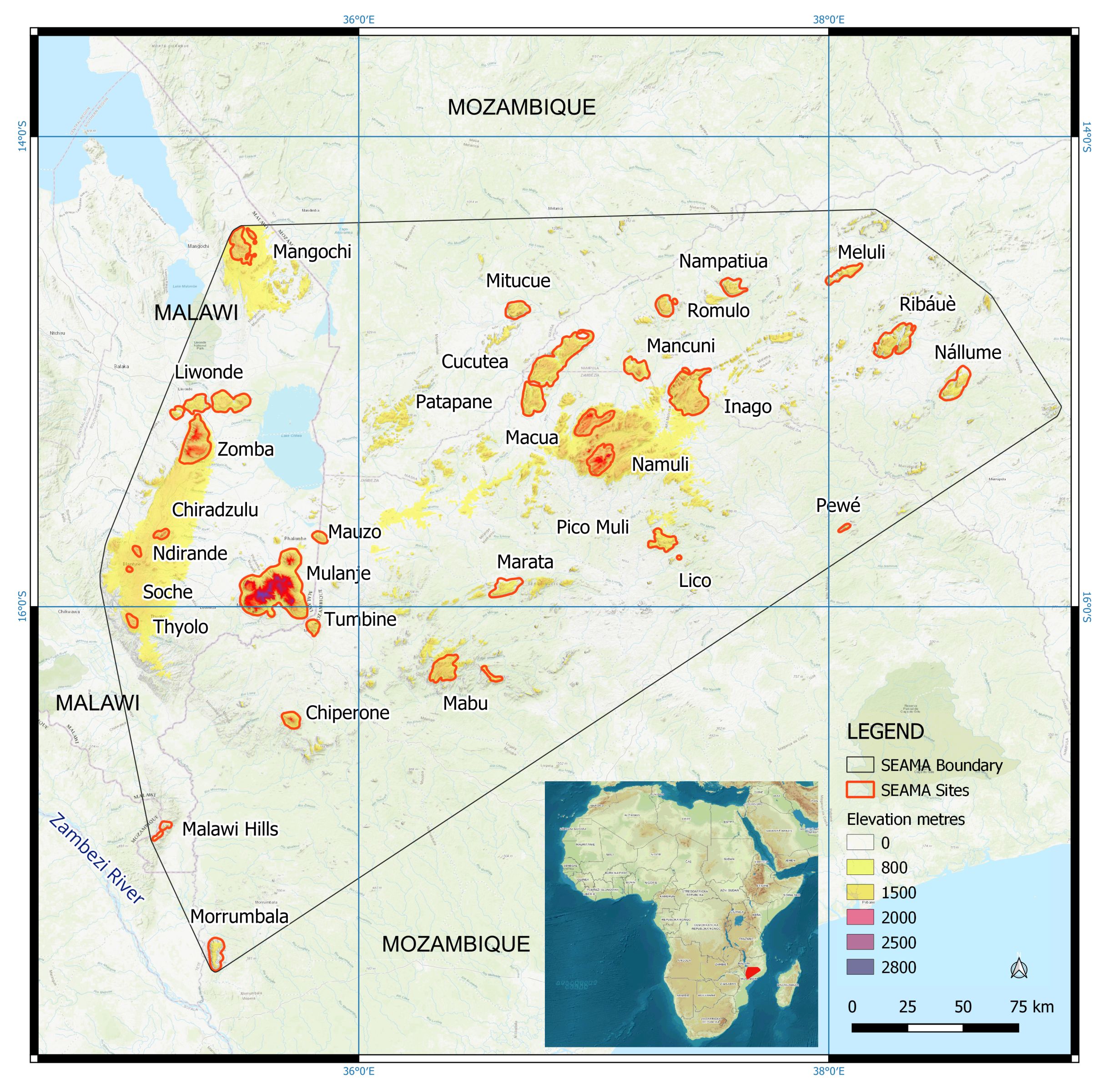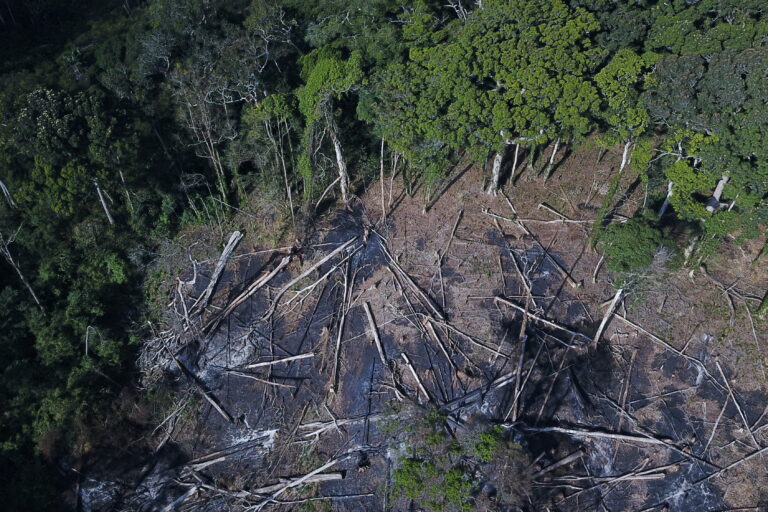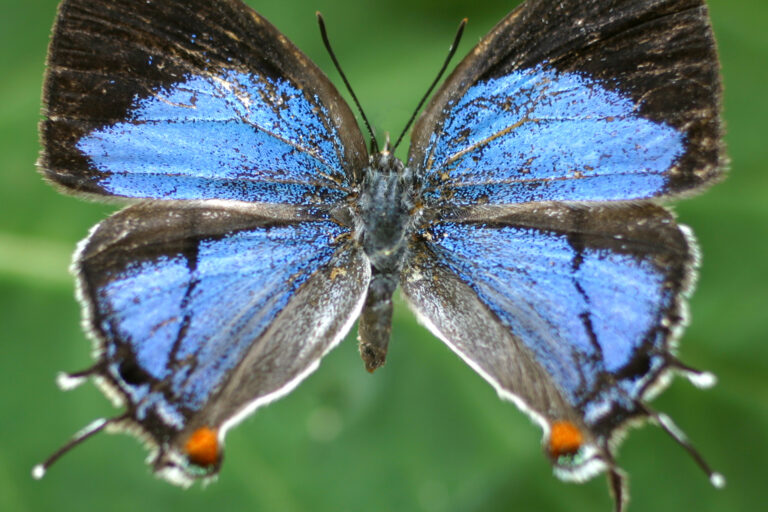A group of scientists is proposing the designation of a new African “ecoregion” consisting of an “inland archipelago” of 30 isolated mountains, some harboring animals and plants found nowhere else on Earth.The South East Africa Montane Archipelago straddles southern Malawi and northern Mozambique.This geographical isolation has fueled the evolution of separate species within the forests that grow on them, and those forests are now severely threatened by charcoal production and agriculture.It’s hoped the designation of a new ecoregion encompassing these mountains will promote nature conservation on a landscape-wide scale.
There is an “inland archipelago” of mountains stretching across southern Malawi and northern Mozambique — a chain of hard granite inselbergs lifted high above the surrounding landscape as it weathered down over millions of years. These “sky islands”, as they’re also known, are topped with high-altitude grasslands and evergreen forests and watered by cool moist winds from the Indian Ocean to the east. A group of researchers is now making the case to declare a new “ecoregion” that will strengthen protection for these inselbergs, whose forest patches, thought once to have been linked to those in Central Africa, still host unique communities of animals and plants.
Researcher Julian Bayliss discovered one new species of snake by stepping on it. Both the snake, a 45-centimeter-long (1.5 foot-long) bush viper, and Bayliss, a biodiversity and protected area management specialist, were unharmed, and the snake was collected and later described as new to science and given the name Mabu bush viper (Atheris mabuensis) in honor of the mountain where he found it.
The incident was one of Bayliss’ many highlights over 20 years spent documenting the rich diversity of plants and animals of this region.
He and 25 colleagues he has worked alongside are now proposing Mabu and the other 30 or so mountains in this transboundary biological treasure be declared a brand new ecoregion: —the South East Africa Mountain Archipelago (SEAMA) — to support landscape-wide conservation initiatives.
“Instead of single-site [conservation] initiatives you can now have ecoregion-wide conservation initiatives targeting many of the sites with a recognized identity, similar to the Eastern Arc Mountains of Tanzania or the Albertine Rift ecoregion [in East Africa],” says Bayliss, who is the lead author of a new study proposing the ecoregion.
A Mabu bush viper, one of many new species recorded for science in the South East Africa Mountain Archipelago. Image courtesy William Roy Branch. View of rainforest on Mount Nallume, with other peaks in the background. Image courtesy Julian Bayliss.
View of rainforest on Mount Nallume, with other peaks in the background. Image courtesy Julian Bayliss.
Protecting a chain of linked landscapes
SEAMA has higher levels of reptile endemism, or reptile species unique to it, than the much larger Albertine Rift ecoregion, Bayliss notes.
Some, like the viper Bayliss trod on, are found nowhere else on Earth. The snake’s DNA has been sequenced, and the date of its divergence from its nearest relatives estimated at 15 million years ago.
Half a dozen species of pygmy chameleons from the genus Rhampholeon also persist only on separate mountains within the SEAMA ecoregion. Mount Mabu has its own, as do mounts Namuli and Inago to the northeast, Mount Chiperone to the southwest and Malawi’s Mount Mulanje and the Malawi Hills.
Sustained, coordinated conservation action is urgently needed across this shared landscape.
Nearly all of the 30 mountains within the proposed ecoregion are threatened by fires and deforestation from charcoal production and shifting agriculture. The latter entails farmers cutting and burning trees and planting crops on the naturally fertilized soils until they’re exhausted and then moving to a new patch of forest.
The new study shows that since 2000, SEAMA is estimated to have lost 18% of its primary humid forest cover and up to 43% in some individual sites, though even that is thought to be an underestimate. The data the study uses only deal with the loss of primary rainforest, not secondary forest — that which has already been disturbed or altered by humans.
At least three sites in Malawi have already lost all of their primary forest. These include Mount Thyolo, where the Thyolo alethe (Chamaetylas choloensis), a small thrush-like bird with rust-colored wings and a pale breast, once lived. Thyolo alethes can persist in tiny forest patches as long as they have anthills in them to supply them with food, but the birds have now disappeared from the mountain where they were first described.
“The whole of Thyolo mountain, the whole of the forest reserve has been completely clear-felled; there’s nothing left,” says Bayliss.
Fortunately, the Thyolo alethe is also found on Mount Mabu and other sites in Mozambique, highlighting the importance of having a defined boundary around this cross-border region of threatened biodiversity.
Carl Bruessow, director of Malawi’s independent Mulanje Mountain Conservation Trust, sees the creation of SEAMA as reinforcement for the work his organization does. The trust runs the internationally recognized Mount Mulanje Biosphere Reserve and partners with conservation groups that promote community-based conservation and livelihoods in Mozambique.
One of the trust’s many projects is to grow and replant seedlings of the iconic yet vulnerable Mulanje cycad (Encephalartos gratus), whose wild populations have been reduced through habitat loss. Tens of thousands of seedlings have been raised in nurseries to be planted across Mount Mulanje, and the work extends to Mozambique’s Milange district and Timbane, an outlying mountain that is part of the Mulanje Massif.
But this kind of conservation work is sometimes misunderstood by officials. On a recent trip , a Mozambican official stopped Bruessow from transporting young cycad plants across the border for replanting in Milange.
“If SEAMA can give us the basis to give the bureaucrats and technocrats more confidence to see that this is a real transfrontier conservation area, and worthwhile supporting, then we start to push our chess pieces a bit more confidently towards getting this reality,” says Bruessow.
 The Thyolo alethe has vanished from the Malawi mountain where it was first described, but can still be found on other inselbergs across the border in Mozambique. Image courtesy Julian Bayliss.
The Thyolo alethe has vanished from the Malawi mountain where it was first described, but can still be found on other inselbergs across the border in Mozambique. Image courtesy Julian Bayliss. Map of the proposed South East Africa Mountain Archipelago.
Map of the proposed South East Africa Mountain Archipelago.
Precious habitat at risk
Although Mozambican conservation groups are working at many of the inselberg sites in that country, habitat loss is a real threat there. One prominent example is Mount Namuli, where farmers have removed around 30% of the massif’s primary forest cover since 2000 to grow crops such as potatoes and maize, threatening the home of Mozambique’s newest-described species of mammal, the Namuli horseshoe bat (Rhinolophus namuli).
Apart from being good for bats, Mount Namuli is also the richest site nationally for endemic plants, with 19 known only from the mountain, according to a 2023 study documenting Mozambique’s important plant areas.
Beyond that, it has intrinsic value. Bayliss recalls one “quite magical” evening in around 2007 as he sat waiting for bats to fly into mist nets set up above streams at the top of Mount Namuli so that he and colleagues could gather information on the animals.
“I suddenly noticed that the ground I was sitting on started to light up with phosphorescent fungi, and then around 100 fireflies came out and were all dancing around my head,” he says.
The work to find out what else lives in threatened forest fragments across SEAMA that haven’t yet been surveyed, is more pressing than ever.
Species unique to individual mountains, such as the pygmy chameleons or mongrel frogs — a genus with separate species living on Mount Namuli and nearby Mount Inago, which has lost 39% of its forests since 2000 — don’t have the capacity to migrate. Once moist forest refuges like these are degraded or destroyed, a “chain reaction” of soil dessication and forest fragmentation ensues, says Harith Farooq, a Mozambican macroecologist and co-author of the study.
“Many species are unable to go from patch to patch due to the high temperatures and due to their own biology, and so their populations get much more fragmented and genetically inbred, which eventually contributes to their extinction,” he says.
“A poorly studied area, [under] constant degradation will result in the extinction of many species already described and many others that have not yet been documented.”
 Felled trees and burned ground in the forest on Mount Nallume: around 18% of the SEAMA’s primary forest has been lost to agriculture, charcoal production, and fires since 2000. Image courtesy Julian Bayliss.
Felled trees and burned ground in the forest on Mount Nallume: around 18% of the SEAMA’s primary forest has been lost to agriculture, charcoal production, and fires since 2000. Image courtesy Julian Bayliss. Epamera malaikae, one of many newly-described species found in the sky islands of Malawi and Mozambique. Image courtesy Colin Congdon.
Epamera malaikae, one of many newly-described species found in the sky islands of Malawi and Mozambique. Image courtesy Colin Congdon.
A phenomenal opportunity
SEAMA presents a “phenomenal” opportunity for a network of organizations and communities to work across the landscape and exchange experiences and methodologies, says social anthropologist Filipa Oitavén, who was not part of the SEAMA study.
But, she says, it’s also important to acknowledge that solutions for protecting the “sky islands” are often deeply rooted in the unique social and cultural context of each individual site.
Oitavén, who is a manager for conservation group Legado’s Mount Namuli Thriving Future Program, says under Legado’s watch, ensuring the health of Namuli’s forests is integrated with providing local communities’ access to quality health facilities.
“Many of these sky islands [within SEAMA] are home to local communities who should be regarded as the key stewards of these landscapes, and thus the most important allies in creating sustainable and long-term protection for these places,” she says.
The forests on Mount Mabu, more than 100 kilometers (62 miles) to the southwest of Namuli, are a prime example. They have great spiritual significance to local communities whose stewardship of the trees has meant that Mabu, the site of the largest rainforest in Southern Africa, has lost only 3% of its primary forest cover since 2000, according to the study.
Bayliss, who also works for Mozambique’s National Network for Community Management of Natural Resources (ReGECom), and some of his co-authors are now part of a consortium that has been given a mandate by the Mozambican government to turn Mount Mabu into a community conservation area.
“This is the start of a new chapter,” Jose Monteiro, director of ReGECom and a co-author of the study, says in a statement.
“A real effort is now required to reduce the threats to this mountain ecoregion and to effectively engage communities in leading conservation efforts, similar to the work at Mount Mabu.”
Banner image: A chameleon (Rhampholeon maspictus) from Mount Mabu. Image courtesy Christophe Bernier.
Related audio from Mongabay’s podcast: The lead researcher on this study, Julian Bayliss, discusses inselbergs and southern Africa’s fascinating and biodiverse forests, listen here:
See related reading:
Secrets revealed: Researchers explore unique, isolated forest in Mozambique
Rare pygmy chameleon, lost to science, found in dwindling Malawi forest
Citations:
Bayliss, J., Bittencourt-Silva, G. B., Branch, W. R., Bruessow, C., Collins, S., Congdon, T. C., … Platts, P. J. (2024). A biogeographical appraisal of the threatened south East Africa montane archipelago ecoregion. Scientific Reports, 14(1). doi:10.1038/s41598-024-54671-z
Richards, S. L., Farooq, H., Matimele, H., Alves, T., Datizua, C., Langa, C., … Darbyshire, I. (2023). Identifying Mozambique’s most critical areas for plant conservation: An evaluation of protected areas and important plant areas. Biotropica, 55(6), 1183-1194. doi:10.1111/btp.13265
FEEDBACK: Use this form to send a message to the author of this post. If you want to post a public comment, you can do that at the bottom of the page.
Animals, Biodiversity, Biodiversity Hotspots, Conservation, Deforestation, Drivers Of Deforestation, Endangered Species, Environment, Farming, Featured, Forests, Habitat Degradation, Habitat Destruction, Habitat Loss, Herps, Lizards, New Discovery, New Species, Protected Areas, Reptiles, Research, Species Discovery, Tropical Forests, Wildlife, Wildlife Conservation
Africa, Malawi, Mozambique, Southern Africa
Source link : https://news.mongabay.com/2024/03/new-ecoregion-proposed-for-southern-africas-threatened-sky-islands/
Author :
Publish date : 2024-03-13 07:00:00
Copyright for syndicated content belongs to the linked Source.





